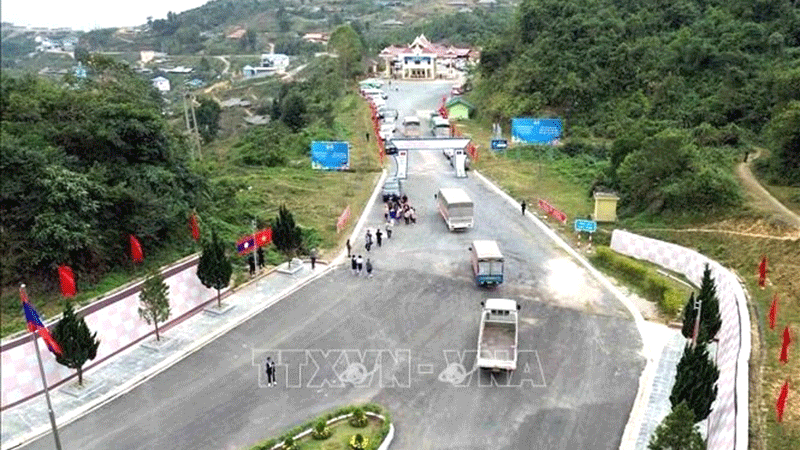 |
| Lorries from Vietnam exit the country via the Song Lap International Border Gate (Vietnam) en route to Pa Hang (Laos). --Photo VNA |
Vietnam, Laos push toward effective, sustainable trade relations
Hanoi (VNA) -- State President Luong Cuong’s state visit to Laos is expected to provide an opportunity for the two sides to advance bilateral ties in a more substantive, practical, and sustainable manner, especially in terms of trade.
Trusted neighbours
Vietnam and Laos share a border line stretching over 2,300 kilometres which runs through 10 provinces in each country. This frontier is strategically positioned along the East–West Economic Corridor, offering substantial potential for development. Along the shared border, the two countries have established a network of border crossings, including nine international border gates, six main gates, 18 auxiliary checkpoints, and 27 designated crossings. In addition, nine border gate economic zones have already been formed.
In 2015, the two countries signed the Vietnam–Laos Border Trade Agreement, which was initially valid until 2018 and extended until the end of 2024. A new Vietnam–Laos bilateral trade agreement was signed on April 8, 2024 and came into effect on February 24, 2025. Additionally, on January 9, 2025, the Vietnamese Minister of Industry and Trade and the Minister of Energy and Mines of Laos signed a new agreement on coal and electricity trade. This agreement took effect immediately upon signing.
According to the Department of Foreign Market Development under Vietnam’s Ministry of Industry and Trade, recent years have seen the total value of bilateral trade surpass US$2 billion. Both sides are now aiming to increase the figure to US$5 billion, with annual growth averaging around 12 percent. Statistics from the Department of Customs showed that in 2024, trade between Vietnam and Laos reached US$2.25 billion, up 38.2 percent from the previous year. Of which, Vietnam exported US$755.2 million worth of goods to Laos, up by 41.6 percent, while imports from Laos stood at US$1.5 billion, a rise of 36.5 percent.
In the first quarter of 2025, two-way trade reached US$980.1 million, a surge of 105.5 percent compared to the same period in 2024. Exports from Vietnam valued at US$346.4 million, representing soaring 138.6 percent. Meanwhile, imports from Laos rose by 91.1 percent to US$633.6 million.
Vietnam’s exports to Laos are undergoing a notable transformation in terms of structure. Industrial goods, chemicals, and construction materials are now taking centre stage, showing record growth. Key exports from Vietnam to Laos include chemical products, machinery and equipment, iron and steel products, animal feed and raw materials, and various vehicles and components. Meanwhile, Vietnam imports raw materials such as rubber, coal, fertiliser, timber, minerals, and maize to serve as vital inputs for domestic industries.
The trade structure shifted significantly in the first quarter of 2025. Industrial goods and raw materials increasingly replaced the more traditional agricultural and fuel-based exports. Estimates for the first four months of 2025 suggest total trade volume will reach around US$1.3 billion, up by 112.6 percent year-on-year. Of that, Vietnam’s exports are expected to hit approximately US$466.8 million, an impressive rise of 150.8 percent, while imports from Laos are projected to reach US$852.7 million, up by 96.2 percent. At present, Vietnam maintains a trade deficit with Laos, estimated at about US$386 million, which is 55.3 percent higher than in the same period last year.
In terms of investment, Vietnamese businesses have run 267 projects in Laos, with total registered capital of US$5.7 billion, with roughly US$2.8 billion disbursed. Many of these ventures are performing well and have made substantial contributions to Laos’s socio-economic development.
At the 47th meeting of the Vietnam–Laos Inter-Governmental Committee, held in January 2025 in Laos, both sides signed four major cooperation documents. These included the official minutes of the session, a 2025 cooperation plan between the two governments, a formal agreement on coal and electricity trade, and a cooperation plan between the education ministries of both countries. Additionally, 13 investment certificates and licences were awarded during the meeting, with a total value of approximately US$1.8 billion.
(Latest Update April 23, 2025)
|